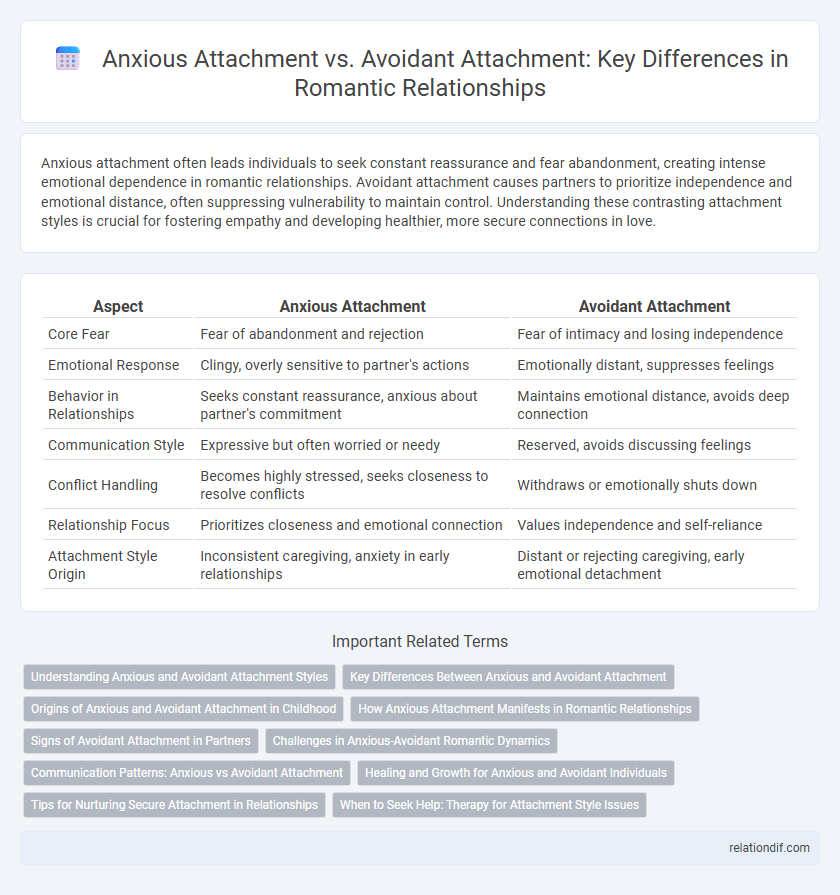Anxious attachment often leads individuals to seek constant reassurance and fear abandonment, creating intense emotional dependence in romantic relationships. Avoidant attachment causes partners to prioritize independence and emotional distance, often suppressing vulnerability to maintain control. Understanding these contrasting attachment styles is crucial for fostering empathy and developing healthier, more secure connections in love.
Table of Comparison
| Aspect | Anxious Attachment | Avoidant Attachment |
|---|---|---|
| Core Fear | Fear of abandonment and rejection | Fear of intimacy and losing independence |
| Emotional Response | Clingy, overly sensitive to partner's actions | Emotionally distant, suppresses feelings |
| Behavior in Relationships | Seeks constant reassurance, anxious about partner's commitment | Maintains emotional distance, avoids deep connection |
| Communication Style | Expressive but often worried or needy | Reserved, avoids discussing feelings |
| Conflict Handling | Becomes highly stressed, seeks closeness to resolve conflicts | Withdraws or emotionally shuts down |
| Relationship Focus | Prioritizes closeness and emotional connection | Values independence and self-reliance |
| Attachment Style Origin | Inconsistent caregiving, anxiety in early relationships | Distant or rejecting caregiving, early emotional detachment |
Understanding Anxious and Avoidant Attachment Styles
Anxious attachment manifests as a deep fear of abandonment, leading individuals to seek constant reassurance and emotional closeness in romantic relationships. Avoidant attachment causes a heightened need for independence, where partners often distance themselves emotionally to avoid vulnerability. Understanding these divergent attachment styles aids in fostering healthier communication and emotional balance between partners.
Key Differences Between Anxious and Avoidant Attachment
Anxious attachment is characterized by a fear of abandonment and excessive need for closeness, often leading to clinginess and emotional dependence in romantic relationships. Avoidant attachment, by contrast, involves discomfort with intimacy and a preference for emotional distance, causing individuals to suppress their feelings and avoid vulnerability. These fundamental differences influence how partners communicate, manage conflict, and express love, ultimately shaping relationship dynamics and satisfaction.
Origins of Anxious and Avoidant Attachment in Childhood
Anxious attachment often develops in childhood due to inconsistent caregiver responsiveness, where the child experiences unpredictability in emotional support and becomes hyper-vigilant to signs of rejection. Avoidant attachment originates from caregivers who are emotionally unavailable or rejecting, leading the child to suppress attachment needs and prioritize self-reliance. Both attachment styles reflect early relational patterns that shape adult romantic dynamics by influencing trust, intimacy, and emotional regulation.
How Anxious Attachment Manifests in Romantic Relationships
Anxious attachment in romantic relationships often manifests as a heightened need for reassurance and fear of abandonment, leading to clinginess and emotional dependency. Partners with anxious attachment may exhibit frequent worry over relationship stability and engage in excessive communication to seek validation. This attachment style can cause challenges such as jealousy, sensitivity to perceived rejection, and difficulty trusting their partner's commitment.
Signs of Avoidant Attachment in Partners
Partners with avoidant attachment often exhibit emotional distance, difficulty expressing feelings, and reluctance to commit. They may prioritize independence over intimacy, frequently withdrawing during conflicts or when emotions intensify. Signs include minimizing the importance of the relationship and avoiding vulnerability to maintain control and personal space.
Challenges in Anxious-Avoidant Romantic Dynamics
Anxious-avoidant romantic dynamics often lead to inconsistent communication patterns, where the anxious partner seeks closeness while the avoidant partner distances themselves, creating a cycle of emotional push-pull. These conflicting attachment behaviors generate mistrust and heightened sensitivity to rejection, intensifying relationship insecurity. Without effective emotional regulation and empathy, these challenges can undermine intimacy and long-term relationship stability.
Communication Patterns: Anxious vs Avoidant Attachment
Anxious attachment in romantic relationships often manifests through heightened emotional expression and a strong desire for reassurance, leading to frequent check-ins and sensitivity to perceived rejection. Avoidant attachment, by contrast, typically features emotional distancing, reluctance to share feelings, and a preference for self-reliance, resulting in minimal communication and withdrawal during conflicts. Understanding these distinct communication patterns is crucial for partners to navigate misunderstandings and foster healthier emotional connections.
Healing and Growth for Anxious and Avoidant Individuals
Healing anxious attachment involves building self-awareness and developing emotional regulation skills to foster secure connections, while avoidant attachment requires cultivating vulnerability and trust to embrace intimacy. Therapeutic approaches such as cognitive-behavioral therapy and attachment-based therapy effectively support emotional growth and relational resilience in both anxious and avoidant individuals. Consistent practice of mindfulness and effective communication enhances self-esteem and deepens relational bonds, promoting lasting transformation in romantic relationships.
Tips for Nurturing Secure Attachment in Relationships
Fostering secure attachment in relationships involves consistent emotional availability and open communication to address the needs of both anxious and avoidant partners. Practicing empathy and validating each other's feelings helps reduce defensive behaviors and build trust. Establishing clear boundaries while encouraging vulnerability creates a balanced dynamic that promotes emotional safety and connection.
When to Seek Help: Therapy for Attachment Style Issues
Seeking therapy for attachment style issues is essential when anxious or avoidant behaviors consistently disrupt intimacy and emotional connection in romantic relationships. Professional counseling, such as cognitive-behavioral therapy or attachment-based therapy, can help individuals recognize patterns of fear of abandonment or emotional distancing. Early intervention promotes healthier relationship dynamics and emotional resilience by addressing underlying attachment wounds.
Anxious Attachment vs Avoidant Attachment Infographic

 relationdif.com
relationdif.com